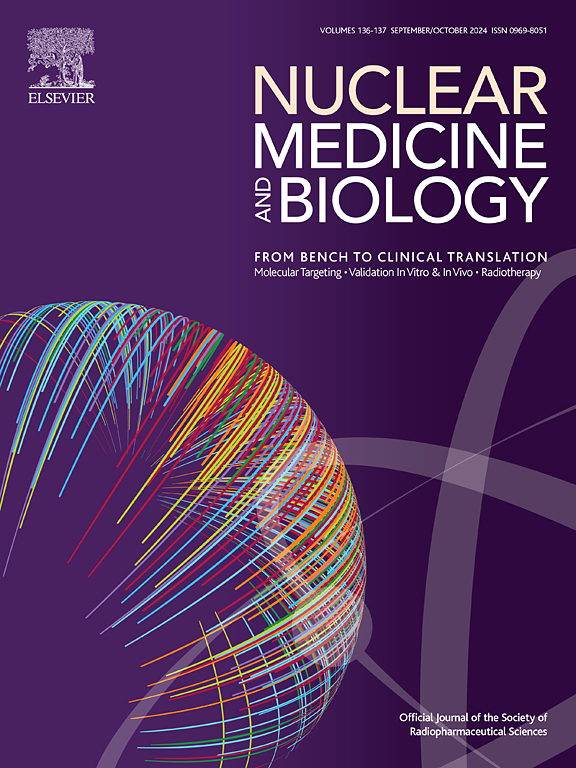Novel dibutyl ether resin for the purification of the Auger emitter antimony-119 from tin targets
IF 3.6
4区 医学
Q1 RADIOLOGY, NUCLEAR MEDICINE & MEDICAL IMAGING
引用次数: 0
Abstract
Antimony-119 (119Sb, t1/2 = 38.19 h) is an Auger electron emitting radionuclide of interest for radiopharmaceutical therapy (RPT). The potential of 119Sb has only been explored theoretically, due to the absence of a suitable bifunctional chelator that enables the attachment of the radionuclide onto a radiopharmaceutical. Meanwhile, potential chelators are difficult to evaluate given that the production and radiochemical purification of 119Sb has not been optimized for radiopharmaceutical applications. 119Sb can be produced from proton bombardment of tin-119 (119Sn) targets on medical cyclotrons, subsequently the nanograms of radioantimony must be efficiently separated from the macroscopic (> mg) amount of target material while being recovered in a matrix suitable for chelation. To this end, a solid phase extraction (SPE) method employing a novel dibutyl ether (DBE) resin was developed to separate radioantimony from tin targets. The DBE resin was synthesized and characterized using thermogravimetric analysis, total organic carbon, and 1H nuclear magnetic resonance spectroscopy. The DBE resin exhibited excellent capacity (>8 mg Sb per gram) and integrity. Distribution coefficients (KD) for Sb(V) (KD up to 4600) and Sn(IV) (KD <0.3) showed good separation (Separation factor of >15,000) of both elements at high concentrations of HCl. Finally, dynamic separations with the DBE resin were capable of recovering up to 79 ± 2 % of radioantimony (1xxSb(III)) in 2 mL of 0.5 M sodium thioglycolate solution when separating nanogram quantities of 1xxSb from tens of milligrams of stable tin. Quantitative recovery of Sn was also achieved in just 1.5 mL of concentrated hydrochloric acid, indicating the potential for target recycling of enriched 119Sn required for pre-clinical evaluation of 119Sb.

新型二丁基醚树脂用于从锡靶中纯化俄歇发射体锑-119
锑-119 (119Sb, t1/2 = 38.19 h)是一种对放射性药物治疗(RPT)感兴趣的俄歇电子发射放射性核素。由于缺乏合适的双功能螯合剂使放射性核素附着在放射性药物上,119Sb的潜力仅在理论上进行了探索。同时,由于119Sb的生产和放射化学纯化尚未针对放射性药物应用进行优化,因此难以评估潜在的螯合剂。在医用回旋加速器上,质子轰击tin-119 (119Sn)靶标可产生119Sb,随后必须有效地将纳克放射性锑从宏观(>;Mg)的目标材料量,同时在适合螯合的基质中回收。为此,建立了一种新型二丁基醚(DBE)树脂固相萃取(SPE)方法来分离放射性锑和锡靶。合成了DBE树脂,并用热重分析、总有机碳和1H核磁共振波谱对其进行了表征。DBE树脂具有优良的容量(8mg Sb / g)和完整性。Sb(V) (KD高达4600)和Sn(IV) (KD <0.3)的分布系数(KD <0.3)在高浓度HCl下表现出较好的分离效果(分离因子>; 15000)。最后,当从数十毫克稳定锡中分离出纳克量的1xxSb时,DBE树脂在2ml 0.5 M巯基乙酸钠溶液中可回收高达79±2%的放射性锑(1xxSb(III))。在1.5 mL的浓盐酸中也实现了Sn的定量回收,这表明了119Sb临床前评估所需的富集119Sn的目标回收潜力。
本文章由计算机程序翻译,如有差异,请以英文原文为准。
求助全文
约1分钟内获得全文
求助全文
来源期刊

Nuclear medicine and biology
医学-核医学
CiteScore
6.00
自引率
9.70%
发文量
479
审稿时长
51 days
期刊介绍:
Nuclear Medicine and Biology publishes original research addressing all aspects of radiopharmaceutical science: synthesis, in vitro and ex vivo studies, in vivo biodistribution by dissection or imaging, radiopharmacology, radiopharmacy, and translational clinical studies of new targeted radiotracers. The importance of the target to an unmet clinical need should be the first consideration. If the synthesis of a new radiopharmaceutical is submitted without in vitro or in vivo data, then the uniqueness of the chemistry must be emphasized.
These multidisciplinary studies should validate the mechanism of localization whether the probe is based on binding to a receptor, enzyme, tumor antigen, or another well-defined target. The studies should be aimed at evaluating how the chemical and radiopharmaceutical properties affect pharmacokinetics, pharmacodynamics, or therapeutic efficacy. Ideally, the study would address the sensitivity of the probe to changes in disease or treatment, although studies validating mechanism alone are acceptable. Radiopharmacy practice, addressing the issues of preparation, automation, quality control, dispensing, and regulations applicable to qualification and administration of radiopharmaceuticals to humans, is an important aspect of the developmental process, but only if the study has a significant impact on the field.
Contributions on the subject of therapeutic radiopharmaceuticals also are appropriate provided that the specificity of labeled compound localization and therapeutic effect have been addressed.
 求助内容:
求助内容: 应助结果提醒方式:
应助结果提醒方式:


